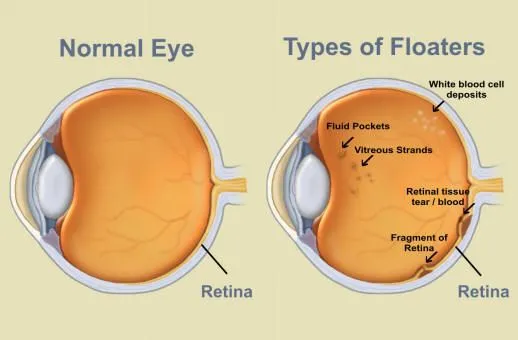Have you ever tried to grab a bug flying around your eye? Or thought you have something in your eye and you just want to wait till it goes away? What exactly is that? What does it come from? And can you get rid of it? Should you immediately go see your doctor? In some cases "yes", in most cases "no".
The below information is mainly summarized and sourced from wikipedia. For more info please visit the site: https://en.wikipedia.org/wiki/Floater
Floaters are deposits of various size, shape, consistency, refractive index, and motility within the eye's vitreous humour, which is normally transparent. Sometimes they can get larger and no longer transparent. At a young age, the vitreous is transparent, but as one ages, imperfections gradually develop. The common type of floater, is present in most persons' eyes, is due to degenerative changes of the vitreous humour. The perception of floaters is known as myodesopsia, or less commonly as myodaeopsia, myiodeopsia, or myiodesopsia. They are also called Muscae volitantes (Latin: "flying flies"), or mouches volantes (from the French).
Floaters are visible because of the shadows they cast on the retina or refraction of the light that passes through them, and can appear alone or together with several others in one's visual field. They may appear as spots, threads, or fragments of cobwebs, which float slowly before the observer's eyes. As these objects exist within the eye itself, they are not optical illusions but are entoptic phenomena. They are not to be confused with visual snow, although these two conditions may co-exist.



There are various causes for the appearance of floaters, of which the most common are described here. Simply stated, any damage to the eye that causes material to enter the vitreous humour can result in floaters. Floaters can occur when eyes age and in rare cases, floaters may be a sign of retinal detachment or a retinal tear.
While surgeries do exist to correct for severe cases of floaters, there are currently no medications (including eye drops) that can correct for this vitreous deterioration. Floaters are often caused by the normal aging process and will usually disappear as the brain learns to ignore them. Looking up/down and left/right will cause the floaters to leave the direct field of vision as the vitreous humour swirls around due to the sudden movement. If floaters significantly increase in numbers and/or severely affect vision, then one of the below surgeries may be necessary.
Aggressive marketing campaigns are currently promoting the use of laser vitreolysis for the treatment of floaters. No strong evidence currently exists for the treatment of floaters with laser vitreolysis. Currently, the strongest available evidence comparing these two treatment modalities are retrospective case series.



